The Role of Middle Finger Stickers in Skate Culture
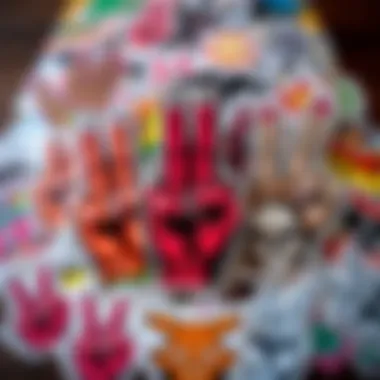
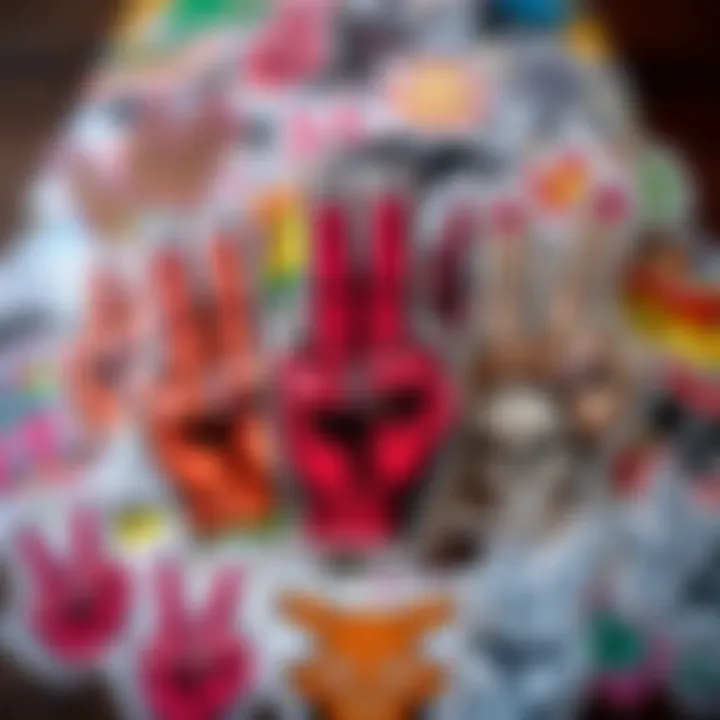
Intro
In the vibrant world of skateboarding, culture and expression intertwine seamlessly. One of the more curious yet poignant symbols within this subculture is the middle finger sticker. It’s not merely a rebellious gesture; rather, it embodies a rich tapestry of identity, sentiment, and artistry.
As skateboarders navigate through their journey—whether it’s mastering tricks or simply cruising down the neighborhood streets—they often choose stickers that reflect their personalities. Among these, the middle finger sticker stands tall, signaling defiance and individuality.
This article aims to peel back the layers of this bold expression, uncovering its historical context, exploring the artistic variations, and examining the psychological implications tied to its use. Far from a trivial graphic, these stickers tell stories of rebellion against norms and the unbreakable bond of community among skateboarders.
Understanding the role of these stickers in the broader skateboard culture not only enriches our appreciation of the sport but also illustrates how art serves as a powerful medium for personal and communal expression.
The Origins of the Middle Finger Sticker
The middle finger sticker occupies a unique niche within the world of skateboarding culture. Its roots are deeply embedded in the rebellious spirit that defines skateboarding, echoing a larger narrative of defiance against societal norms. Understanding the origins of this seemingly simple sticker unveils layers of meaning, reflecting on both personal individuality and collective identity within the skateboarding community.
Historical Context
To appreciate the middle finger sticker properly, we have to take a step back in time. Stickers, in general, have been a part of street culture for decades. The late 1970s witnessed the emergence of punk rock, which brought about a wave of anti-establishment sentiment. Skateboarding, weaving its way into this grunge aesthetic, naturally adopted symbols that resonated with the ethos of rebellion. The middle finger, a gesture of defiance, became synonymous with rejecting authority and embracing a carefree attitude. In the early 1980s, you would find stickers plastered on skateboards, walls, and public spaces, proclaiming this bold stance.
As skateboarding gained traction, particularly in places like California, the middle finger sticker didn't just remain an isolated emblem; it evolved. It became a shared language—each sticker told a story, connected a community, and reflected individual frustrations and triumphs. These stickers served as a bold declaration, often seen as a form of street art, casting a critical eye on societal expectations.
Evolution in Skateboarding
Fast forward to today, the middle finger sticker has morphed into a symbol that transcends mere provocation. While still embodying that raw defiance, it now also represents creativity and self-expression. Skateboarders customize their boards with unique designs, often incorporating this sticker as a powerful element of their identity. The act of slapping a middle finger sticker on one’s skateboard goes beyond just slapping on an image; it's a statement.
As the culture evolved through the '90s and 2000s, with the rise of social media, the middle finger sticker found a new stage. Platforms like Instagram and TikTok led to the resurgence of stickers as a form of art. Skateboarders began sharing their creatively customized boards far beyond local skate parks, creating a vibrant tapestry of designs and meanings. The art became more than just stickers; they symbolized community, trends even flowed through this medium.
In summary, the origins of the middle finger sticker in skateboarding culture serve not only to highlight a specific attitude but also to illustrate an ongoing dialogue between history, identity, and art. Skateboarders—whether seasoned pros or wide-eyed beginners—find in these stickers a way to connect, express, and communicate their love for a culture that honors both rebellion and unity.
Symbolism of the Middle Finger
The middle finger sticker has woven itself into the very fabric of skateboarding culture, acting as a potent symbol of rebellion, individuality, and a sense of belonging. For many skateboarders, this sticker isn’t just a mere decoration; it’s a bold assertion of their identity and values. This section explores the complex layers of meaning attached to this provocative icon, bringing to light how it embodies sentiments of defiance and community within the skateboarding scene.
Rebellion and Defiance
In skateboarding, the act itself stands as an act of defiance against conventional norms. The middle finger, historically a gesture of contempt, perfectly encapsulates this attitude. When a skateboarder chooses to sport a middle finger sticker, they send a clear message: We do not conform. This feeling is rooted deeply in the culture, which often champions nonconformity and challenges societal expectations. The very nature of skateboarding is to carve one's own path, shunning predefined routes. Thus, the sticker becomes not just an image, but rather a manifesto of sorts, uniting skateboarders in their rebellious spirit.
Moreover, the sticker serves as a badge of honor in a way, particularly in street skating where showcasing one's individuality becomes paramount. There's also a sense of camaraderie; when a skateboarder sees someone else sporting the same sticker, it sparks an immediate connection, a silent understanding that transcends words.
Cultural Interpretations
The middle finger sticker cannot be pinned down to a single meaning; it varies greatly depending on cultural context. This variation highlights the diverse interpretations and use of the sticker across different regions and generations.
Regional Variations
Across the globe, the middle finger sticker takes on numerous interpretations. In urban environments like New York City or Los Angeles, it frequently symbolizes a direct challenge to authority, encapsulating the fast-paced, cutthroat spirit of city life. On the other hand, in regions like Scandinavia, the sticker may embody a more laid-back, sarcastic humor reflecting their cultural approach to life.
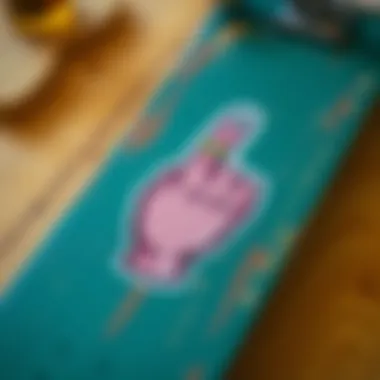

This contrast is significant because it shows how a simple image can morph into something uniquely relevant based on location. Skateboarders resonate with these variations due to their local cultures, asserting that while the gesture might be universally understood, its nuances can vastly differ. This regional twist adds layers to the storytelling within the skateboarding community, enriching the culture as a whole.
Generational Perspectives
Generational interpretation introduces another layer of complexity. Older generations of skaters often view the middle finger sticker through the lens of a punk, DIY ethos, suggesting a fierce independence and often a disdain for any form of establishment. In contrast, younger skateboarders may employ the sticker more lightheartedly or ironically, often mixing it with memes or pop culture references.
Such variations in perception illuminate how the symbol adapts over time. While it once screamed rebellion, it can now also giggle cheekily at conformity, shifting from a single straightforward meaning into a multifaceted cultural artifact. This evolution underscores how the middle finger sticker remains relevant across age groups, revealing new interpretations while maintaining its roots.
"The middle finger sticker represents not just an act of rebellion but a bond that unites us as skateboarders."
For further insights, refer to resources like Wikipedia or Britannica to explore the cultural significance of symbols in society.
Artistic Expression Through Stickers
The realm of skateboarding culture is distinctly vibrant, characterized by a unique form of self-expression and identity. Middle finger stickers play a pivotal role in this domain, serving not just as mere adornments, but as bold proclamations of individuality and attitude. These stickers act as canvases for artistic creativity, allowing skateboarders to communicate their values, beliefs, and personality traits without uttering a single word. The intricate details in the designs or the audacity of the messages often establish a connection among peers, reinforcing the sense of belonging within smaller groups or broader communities.
Design Trends
Design trends in middle finger stickers flourish as diverse as the skateboarders who embrace them. From minimalist black-and-white outlines to intricate, color-saturated illustrations, the diversity is astonishing. Popular styles include graffiti-inspired designs, which exude a raw, urban vibe, or cartoonish, exaggerated characters that add a touch of humor to the assertiveness of the gesture itself. There’s something remarkably unrestrained about using the middle finger as a proclamation of identity;
- Its sharp contrast against skateboard decks transforms a somewhat crude symbol into a piece of art.
- The emergence of psychedelic designs is also noteworthy, drawing inspiration from the vibrant aesthetics seen in surf and punk cultures.
This dynamic range of artistic expression not only encapsulates personal style but also reflects larger socio-cultural shifts. It allows skateboarders to engage with contemporary visual culture, leading to continual evolution in sticker design.
DIY Sticker Culture
Techniques and Materials
The DIY aspect of sticker culture has blossomed into an essential component for many skateboarders. Making your own stickers fosters a genuine form of expression that commercial products often miss. Techniques and materials used range from simple paper and ink to specialized vinyl designed for durability against weather and friction.
- Benefits: Using high-quality vinyl can add a professional touch while ensuring longevity.
- Key Features: The simplicity of vinyl cutting machines, like Cricut, or even traditional hand-drawn designs, empowers individuals to manifest a style that feels authentically theirs.
- Considerations: However, it can be daunting for novices; getting the right materials or learning the crafting techniques is often a barrier. Yet, the end product, a sticker that speaks personal tales or experiences, is worth the effort.
Showcasing Personal Flair
Personal flair is the lifeblood of skateboarding communities revolving around the middle finger sticker phenomenon. Skaters showcase their individuality through custom designs that might signify a personal story or a shared experience within their social circles.
- Key Characteristics: The stickers can be reflections of personal milestones or life philosophies, making their presence on skateboards meaningful.
- Benefits: They can instill a deeper connection among skaters, provoking conversations driven by the sticker's background or artistry.
- Unique Features: The ability for self-expression through these stickers nurtures a sense of pride and ownership among skateboarders. Their consistency in being showcased—on decks, helmets, or even walls—illustrates a collective identity that is instantly recognizable.
In summary, middle finger stickers are so much more than eye-catching designs; they encapsulate the essence of skateboarder individuality, creativity, and allegiance to community. By delving into artistic expression, skateboard culture is not just surviving, it is thriving and evolving.
The Psychological Impact of Middle Finger Stickers
Middle finger stickers hold more than just a rebellious visual appeal in skateboard culture; they resonate deeply with the psychological fabric of identity and community. For many skateboarders, these stickers symbolize a rejection of norms, a declaration of autonomy, and an emblem of belonging. The mere act of applying a middle finger sticker can affect a rider’s perception of self, instilling a sense of pride and individuality.
Identity and Individuality
In the world of skateboarding, having the opportunity to express one’s unique identity is essential. Middle finger stickers provide a platform for such expression. They allow skateboarders to signal their values, attitudes, and even their sense of humor. This form of self-expression empowers individuals to embrace their quirks and personal narratives, setting them apart in a culture that celebrates individuality. The imagery encapsulated in a middle finger sticker is often personal—representing defiance against conventional standards and asserting autonomy.


For many, placing a middle finger sticker on their board is akin to donning a badge of honor. It speaks volumes in a culture where the visual aesthetic is often as important as the skills displayed on a skateboard. Through this simple act, riders can convey a message of rebellion and individuality. They send a clear statement: they adhere to their values, and they welcome others to appreciate their differences.
This sticker isn't just a decal—it's a reflection of an internal struggle, a silent protest against societal pressures. It allows skateboarders to challenge expectations while forming their identities in an unapologetic manner. As an artifact of personal expression, middle finger stickers draw attention to the diverse narratives within skateboarding culture.
Community Connection
Moreover, middle finger stickers play a pivotal role in forging connections among skateboarders. This seemingly simple piece of adhesive art serves as a bridge, linking individuals with similar experiences and ideologies. When one skateboarder spots a fellow rider sporting a middle finger sticker, it sparks an instant rapport—a recognition of shared values and camaraderie.
Skateboarding culture thrives on communal aspects that go beyond mere sporting activities. Middle finger stickers symbolize a collective sentiment of anti-establishment attitudes that unite riders in defiance. They foster an informal social network where stories of rebellion and perseverance can be exchanged freely. This can lead to a profound sense of belonging, where riders feel they are part of a larger movement.
While the middle finger sticker initially signifies individual rebellion, it also cultivates a sense of kinship in a community that understands and encourages the ethos of ‘staying true to oneself’. The presence of these stickers can often be traced back to skateboard parks or DIY spots where like-minded individuals congregate. They become the threads that stitch together disparate narratives, forming a rich tapestry of shared experiences and expressions within skateboarding culture.
"The middle finger sticker stands as both a rebel sign and a badge of belonging, threading together the diverging paths of individual stories within skateboarding culture."
In essence, the psychological impact of middle finger stickers weaves together the motifs of identity and community. They serve not only as artistic flourishes but also as symbols of solidarity, creating a unique language among skateboarders. Discussing these implications provides insight into how something seemingly trivial can impact lives, giving voice to the oft-hidden narratives that skate culture thrives upon.
Middle Finger Stickers in the Digital Age
The digital landscape has transformed how cultural symbols, such as the middle finger sticker, find their way into skateboarding culture. As social media platforms like Instagram, TikTok, and Facebook gain traction, the visibility and reach of such stickers has skyrocketed. The significance markers of rebellion and identity now transcend physical skateboards and spill into the pixels of wrapped screens. It's where these stickers have gone, both literally and figuratively, that makes the subject essential in today's discourse.
In an era where visual expression is paramount, the ease of sharing eye-catching designs plays a significant role. Skateboarders find a sense of community through these shared symbols; they can display their stickers online, amplifying their personal narratives and connecting with like-minded individuals. This aspect of social media creates a space for discussion, appreciation, and critique of the artistry embodied in middle finger stickers. As such, these stickers become not just a display of individuality but a collective representation of the skateboard culture’s anti-establishment ethos.
Sharing Through Social Media
With unique formats for expression, social media allows skateboarders to showcase their affiliation with middle finger stickers in ways that were not previously possible. Instagram influencers, for example, share videos of their latest tricks while prominently featuring their skateboard stickers. This tactic elevates the simple sticker to an emblem of rebellion, identity, and belonging—instantly recognizable within the vast digital sea.
Moreover, hashtags related to skateboard stickers enable enthusiasts to discover trends or even engage in healthy rivalry. By spending time scrolling through feeds, fans can elevate their own sticker game, seeking inspiration. This all boils down to the inherent sharing mechanism on social platforms that makes these stickers more of a cultural phenomenon rather than mere accessories.
Market Trends
E-Commerce Influence
E-commerce has reshaped how skateboarders purchase their stickers. Platforms like Etsy and Redbubble allow budding artists to sell their unique designs directly to consumers. This change cuts out the need for traditional retail, paving the way for more personalized offerings. The stickers are often crafted with care and reflect a certain personality or attitude, and buyers now search for identities that resonate deeply with them.
The ease of online shopping makes it a go-to for many skateboarders. They can browse through countless designs in a blink, ordering stickers from the comfort of their home. A notable characteristic of this setup is the direct feedback loop: customers leave reviews, share their designs, and elevate popular trends, making e-commerce platforms a vibrant hub of artistic collaboration.
However, challenges lie therein as well. Counterfeit designs may surface, impacting both artists’ livelihoods and the integrity of the sticker culture. Nonetheless, the advantages of direct purchasing often outweigh these concerns, keeping the spirit of creativity alive.
Brand Collaborations
Brand collaborations have become another notable trend impacting the landscape of middle finger stickers. As well-known skateboard brands join forces with artists or influencers, the stickers become immensely popular, offering both limited-edition appeal and a sense of exclusivity. This often leads to a community buzz, making these collectibles highly sought after.
The collaboration aspect plays a crucial role in merging artistic expression with commercial viability. Established companies leverage these partnerships for advertising and promotional purposes, leading to unique designs that often resonate with broader audiences. However, skeptics argue that such commercialism could dilute the original meaning of rebellion tied to the stickers.
Legal Considerations Surrounding Stickers
As the world of skateboarding evolves, so too does the sticky business of sticker culture. Particularly, the middle finger sticker phenomenon brings forth a variety of legal matters that many would overlook at first glance. Understanding these nuances is pivotal, not just for skaters but also for manufacturers, retailers, and parents who navigate the landscape of youth culture.
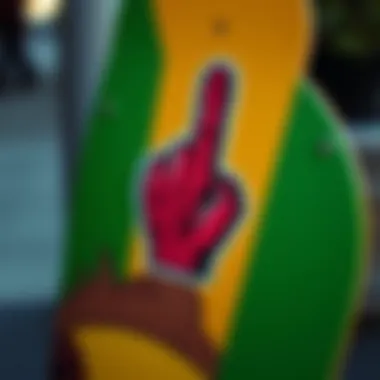
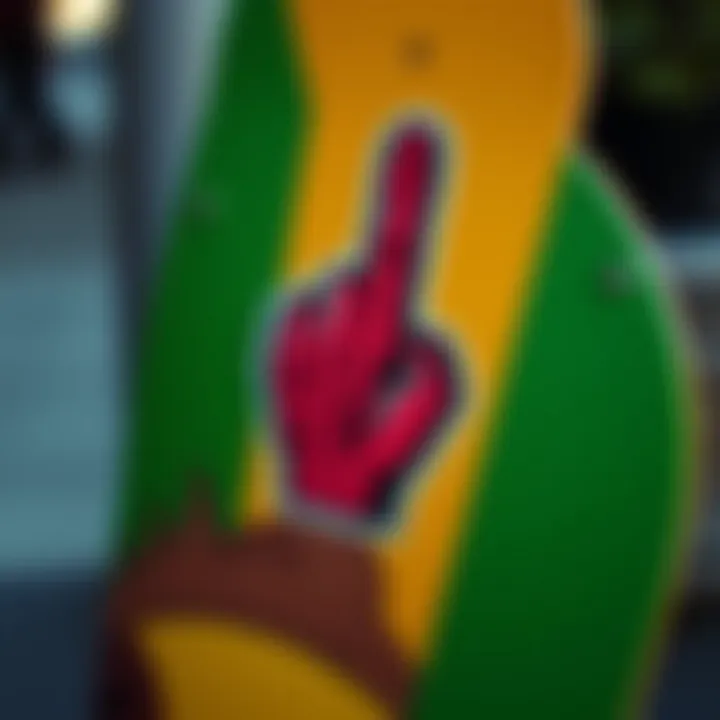
There’s a fine line between artistic expression and legal repercussions, especially when it comes to stickers featuring symbols that could be deemed offensive. So, let’s unravel some of these legal intricacies that figure into the roller coaster of sticker popularity.
Intellectual Property Issues
The realm of intellectual property can feel like a maze, especially in a niche where creativity is the main currency. Middle finger stickers often draw from various artistic inspirations and may incorporate existing designs or logos. This raises a fundamental question:
- Are these stickers infringing on any intellectual property rights?
If a skater or designer creates a sticker that resembles an established brand's logo or character, even unintentionally, they could run headlong into legal trouble. Situations involving trademarks are high-stakes, and many well-known brands have a zero-tolerance policy against unauthorized use of their imagery. This not only applies to logos but also to established styles or recognizable silhouettes associated with larger entities. Therefore, it is wise for creators to tread carefully and, ideally, consult with a legal expert when developing sticker designs.
Moreover, the act of copying designs can lead to serious repercussions, enough to give anyone cold feet. Litigation could involve significant financial costs and reputational damage. In this hyper-visible culture of skateboarding, one misstep could take the fun out of it real quick. Stickers that might seem harmless could land a designer in hot water if they infringe on someone's artistic rights.
Public Perception and Controversy
Public perception adds another layer to this ongoing saga, with the middle finger sticker often caught in the crossfire. The way society views these stickers fluctuates widely depending on the region and community values. Some may see them as a bold statement of individuality, while others might perceive them as blatant disrespect or vulgarity.
- The divide in how these stickers are received isn’t purely cultural; it often overlaps with age, experience, and personal values. This disparity leads to interesting debates:
- Are middle finger stickers just harmless jokes or a representation of a deeper message?
- How do these stickers reflect broader societal attitudes towards rebellion and authority?
In the skateboarding culture, where defiance is often celebrated, these stickers might serve as badges of honor for the rebellious spirit. However, in more conservative circles, they could evoke strong negative reactions. Parents and guardians may find themselves in a dilemma, trying to strike a balance between allowing self-expression and maintaining societal norms.
"The only thing worse than being talked about is not being talked about." – Oscar Wilde
In effect, middle finger stickers symbolize a clash of perspectives. They embody the essence of rebellion, while simultaneously inviting controversy and potential backlash. As stickers begin to reach a wider audience, the discussions surrounding them become increasingly tangled, implicating community standards, cultural sensitivities, and even legal statutes. Thus, it is crucial for skateboarders and the broader community to navigate these waters wisely, ensuring that their self-expression does not inadvertently wade into dubious legality.
Ultimately, as we peel back the layers of this sticker phenomenon, it’s evident that legal considerations surrounding middle finger stickers reflect a microcosm of larger challenges in valuing creative expression while respecting boundaries. Understanding these legal landscapes can make all the difference, whether it’s fostering healthy community engagement or protecting one’s rights in the bustling world of skating.
The Future of Middle Finger Stickers
As skateboarding evolves, so too do the symbols that represent its culture. The middle finger sticker stands as an emblem of defiance and individuality; thus, understanding its future is pivotal in grasping the trajectory of skateboarding culture itself. This section discusses emerging design trends and potential shifts that may redefine the meaning and usage of these stickers.
Emerging Trends in Design
Design trends within the realm of middle finger stickers are always in flux, adapting to new influences while simultaneously pushing boundaries. Several notable patterns are worth exploring:
- Color Palette Shifts: While black and white designs used to dominate, there’s a noticeable transition toward vibrant colors and gradients. This change can reflect the ongoing desire for personal expression and uniqueness among skateboarders. Stickers are becoming a medium for showcasing individuality, allowing skaters to voice their personalities sharply.
- Incorporation of Technology: Some upcoming stickers integrate augmented reality features, enabling users to scan them with their smartphones for an interactive experience. This could create a dynamic tie between the physical and digital skateboarding realms, enhancing community engagement through shared experiences.
- Collaboration with Artists: More skateboarding brands are teaming up with local artists to create limited-edition middle finger stickers. These collaborations aren’t just about aesthetics; they bring attention to local art scenes and give a platform to up-and-coming designers.
- Sustainable Materials: Growing environmental consciousness among skateboarders has also influenced design choices. Stickers made from biodegradable materials are on the rise, marrying rebellious spirit with ecological responsibility.
With these developments, it is clear the future of middle finger stickers is one of innovation and creativity, pushing the cultural envelope while remaining true to the roots of skateboarding.
Potential Shifts in Meaning
As we look towards the horizon, the meaning of the middle finger sticker may also undergo transformations influenced by broader social currents:
- From Rebellion to Acceptance: Initially, the sticker symbolized rebellion against societal norms, but as skateboarding gains increasing mainstream acceptance, its meaning might shift. The middle finger, once a blatant act of defiance, could evolve into a lower-key symbol of self-expression, akin to a personal motto rather than an outright gesture of disrespect.
- Influence of Social Movements: Skateboarding culture is often shaped by contemporary issues. The middle finger sticker could embody stances on social justice or political controversies, turning it into a tool for activism.
"As society changes, so do the symbols we use to communicate our beliefs."
- Generational Reinterpretation: Younger skateboarders may redefine its connotation, adapting the imagery to fit their narratives. This reinterpretation offers a chance for the sticker to convey messages that resonate more with today’s youth, just as it has historically done.
In summation, the future of middle finger stickers in skateboarding culture presents a multifaceted landscape. It’s not merely about the designs or the aesthetics; it reflects the shifting dynamics of identity, community, and the larger societal context surrounding skateboarding.
For further insights into the evolution of symbols within skate culture, consider visiting Wikipedia or engaging in discussions on platforms like Reddit. By looking ahead, we can better appreciate that the humble middle finger sticker will likely remain a relevant, if not pivotal, part of skateboarding culture.















